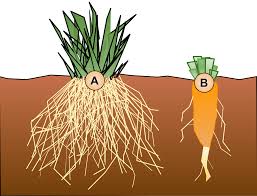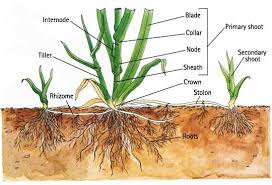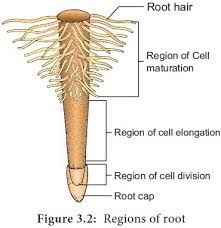Root are cylindrical, underground and non-green part develop from radical. They lack nodes, leaves, buds but give rise to endogenous lateral branches. Exceptions- Root of sweet potato and Dalbergia bear buds. Root move in the direction of gravity ( positive geotropism) and against the direction of light (negative photosyntropism).
The main root and its lateral branches form the root system.
Root:- There are three types of root system:-
(i) Tap root system:- The primary root is directly elongated from the radical and grows inside the soil (e.g.dicots). It bears lateral roots of several orders that are referred to as secondary, tertiary roots etc. The primary roots and its branches constitute the tap root system.
(ii) Fibrous root system:- In monocotyledonous plants, the primary root is short-lived and is generally replaced by a number of the fibrous roots. These roots originate from base of the stem and constitute the fibrous root system as seen in wheat plant.
(iii) Adventitious root system:– Some plants have specialized roots. These roots develop from any parts of the plant other than the radical e.g.Grass, Monstera, Banyan tree.
(i) Absorption of water and minerals from the soil.
(ii) Provide anchorage to the plant parts.
(iii) Storage of reserve food material.
(iv) Synthesis of plant growth regulators.
Root regions:-
(i) Root cap:- The apex of the root is covered by a thimble like structure called root cap. It is multicellular and made up of parenchymatous cells. It protects the tender apex of the root.
(ii) Region of meristematic activity:- This layer is few millimeter above the root cap (sub-apical). The cells of this layer divide repeatedly to produce new cells.

(iii) Region of elongation:- The cells proximal to the meristematic region undergo rapid elongation and enlargement and are responsible for the growth ot the roots in length.
(iv) Region of maturation:- The cells elongation zone gradually differentiate and mature. Hence, this zone proximal to region of elongation, is called the region of maturation.
Some epidermal cells from the region of maturation form very fine and delicate thread-like structure called root hair. The root hair increases the surface area for absorption of water and minerals from the soil.

Roots in some plants undergo modifications in their shape and structure in order to perform functions like respiration, storage and protection.
(i) Storage roots/Fleshy roots:- The primary tap root is modified due to storage of food and assumes various shapes. e.g tap root of carrot, turnip, radish, beet and adventitious roots of sweet patato get swollen and store food.
(ii) Respiratory roots:- In some plants such as Rhizophora growing in swampy areas. Many roots come out of the ground vertically upwards to get oxygen for respiration. Such roots are called pneumatophores

(iii) Prop roots:- They arise from the branches of stem for providing mechanical support to heavy branches, as pillars e.g banyan tree.
(iv) Stilt roots:- They arise from lower nodes of stem to support main axis and enter the soil obliquely e.g sugarcane, maize.
- Plant roots have a surprising ability to “listen” to their environment.
- Recent studies have revealed that roots can detect sounds.
- Specifically, they can sense the sounds of running water.
- This ability is known as “hydro-acoustic signaling.”
- Hydro-acoustic signaling helps roots locate water sources.
- Roots grow towards the sound of water even without direct contact.
- This discovery was made through controlled experiments.
- Researchers played recordings of running water near plant roots.
- The roots grew in the direction of the sound.
- This ability is crucial for survival in dry conditions.
- It allows plants to efficiently find water in their environment.
- The roots use tiny hair-like structures to detect vibrations.
- These structures are sensitive to different frequencies.
- The detection mechanism is still being studied for more details.
- This fascinating trait highlights the complexity of plant behavior.

Morphology refers to the study of the form and structure of plants. In flowering plants, this includes the study of roots, stems, leaves, flowers, fruits, and seeds.
The main parts of a flowering plant include roots, stems, leaves, flowers, fruits, and seeds
Roots anchor the plant in the soil, absorb water and minerals, store food, and sometimes propagate new plants.
There are primarily two types of roots: taproots (main root with smaller lateral roots) and fibrous roots (a network of roots of similar size).
Stems support leaves, flowers, and fruits, transport water, nutrients, and food between roots and other parts of the plant, and sometimes store food.